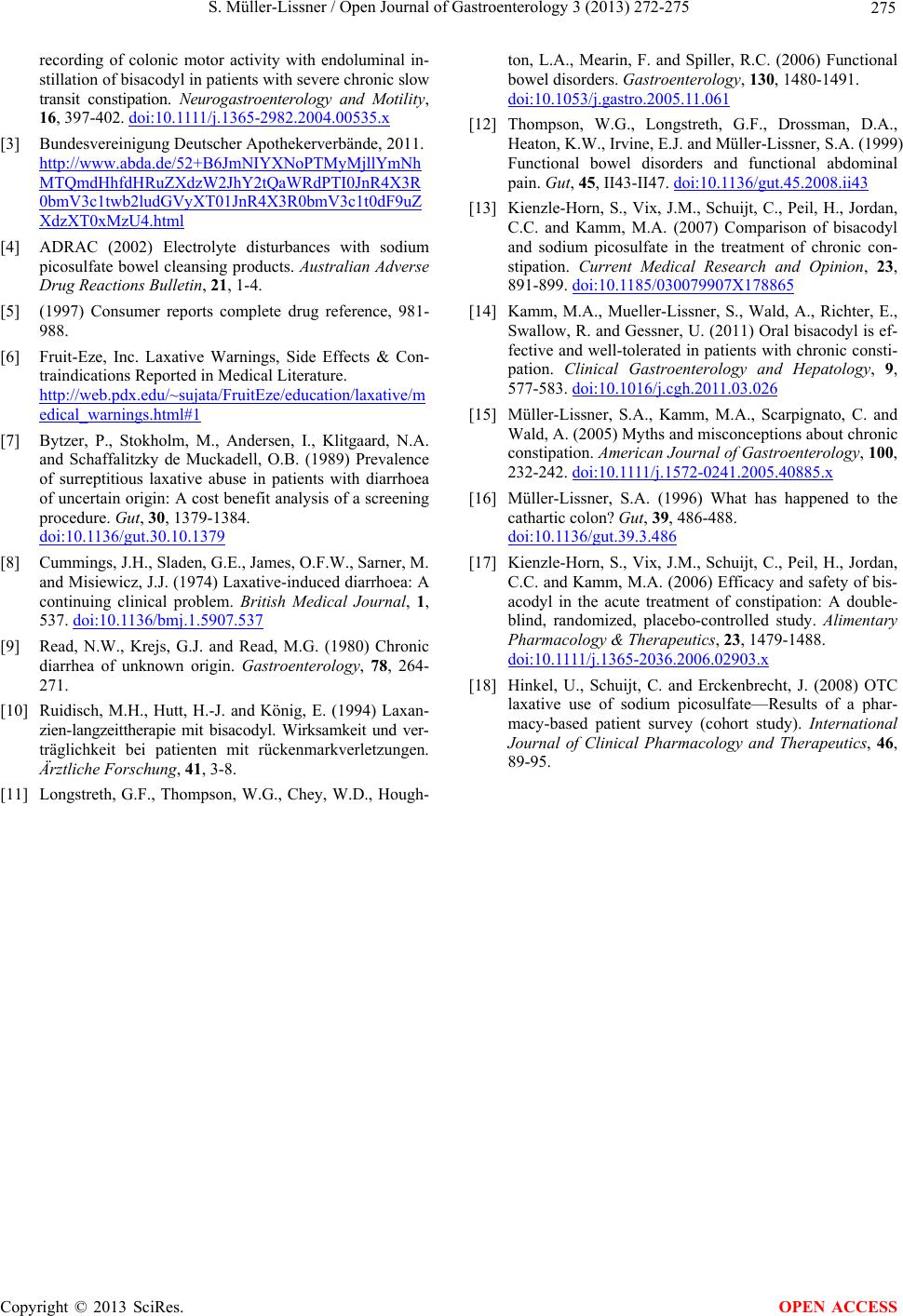
S. Müller-Lissner / Open Journal of Gastroenterology 3 (2013) 272-275 275
recording of colonic motor activity with endoluminal in-
stillation of bisacodyl in patients with severe chronic slow
transit constipation. Neurogastroenterology and Motility,
16, 397-402. doi:10 .1111/j.1365-2982.2004.00535.x
[3] Bundesvereinigung Deutscher Apothekerverbände, 2011.
http://www.abda.de/52+B6JmNIYXNoPTMy MjllYmNh
MTQmdHhfdHRuZXdzW2JhY2tQaWRdPTI0JnR4X3R
0bmV3c1twb2ludGVyXT01JnR4X3R0bmV3c1t0dF9uZ
XdzXT0xMzU4.html
[4] ADRAC (2002) Electrolyte disturbances with sodium
picosulfate bowel cleansing products. Australian Adverse
Drug Reactions Bulletin, 21, 1-4.
[5] (1997) Consumer reports complete drug reference, 981-
988.
[6] Fruit-Eze, Inc. Laxative Warnings, Side Effects & Con-
traindications Reported in Medical Literature.
http://web.pdx.edu/~sujata/FruitEze/education/laxative/m
edical_warnings.html#1
[7] Bytzer, P., Stokholm, M., Andersen, I., Klitgaard, N.A.
and Schaffalitzky de Muckadell, O.B. (1989) Prevalence
of surreptitious laxative abuse in patients with diarrhoea
of uncertain origin: A cost benefit analysis of a screening
procedure. Gut, 30, 1379-1384.
doi:10.1136/gut.30.10.1379
[8] Cummings, J.H., Sl ade n, G.E. , James, O.F. W. , Sarner, M.
and Misiewicz, J.J. (1974) Laxative-induced diarrhoea: A
continuing clinical problem. British Medical Journal, 1,
537. doi:10.1136/bmj.1.5907.537
[9] Read, N.W., Krejs, G.J. and Read, M.G. (1980) Chronic
diarrhea of unknown origin. Gastroenterology, 78, 264-
271.
[10] Ruidisch, M.H., Hutt, H.-J. and König, E. (1994) Laxan-
zien-langzeittherapie mit bisacodyl. Wirksamkeit und ver-
träglichkeit bei patienten mit rückenmarkverletzungen.
Ärztliche Forschung, 41, 3-8.
[11] Longstreth, G.F., Thompson, W.G., Chey, W.D., Hough-
ton, L.A., Mearin, F. and Spiller, R.C. (2006) Functional
bowel disorders. Gastroenterology, 130, 1480-1491.
doi:10.1053/j.gastro.2005.11.061
[12] Thompson, W.G., Longstreth, G.F., Drossman, D.A.,
Heaton, K.W., Irvine, E.J. and Müller-Lissner, S.A. (1999)
Functional bowel disorders and functional abdominal
pain. Gut, 45, II43-II47. doi:10.1136/gut.45.2008.ii43
[13] Kienzle-Horn, S., Vix, J.M., Schuijt, C., Peil, H., Jordan,
C.C. and Kamm, M.A. (2007) Comparison of bisacodyl
and sodium picosulfate in the treatment of chronic con-
stipation. Current Medical Research and Opinion, 23,
891-899. doi:10.1185/030079907X178865
[14] Kamm, M.A., Mueller-Lissner, S., Wald, A., Richter, E.,
Swallow, R. and Gessner, U. (2011) Oral bisacodyl is ef-
fective and well-tolerated in patients with chronic consti-
pation. Clinical Gastroenterology and Hepatology, 9,
577-583. doi:10.1016/j.cgh.2011.03.026
[15] Müller-Lissner, S.A., Kamm, M.A., Scarpignato, C. and
Wald, A. (2005) Myths and misconceptions about chronic
constipation. American Journal of Gastroenterology, 100,
232-242. doi:10.1111/j.1572-0241.2005.40885.x
[16] Müller-Lissner, S.A. (1996) What has happened to the
cathartic colon? Gut, 39, 486-488.
doi:10.1136/gut.39.3.486
[17] Kienzle-Horn, S., Vix, J.M., Schuijt, C., Peil, H., Jordan,
C.C. and Kamm, M.A. (2006) Efficacy and safety of bis-
acodyl in the acute treatment of constipation: A double-
blind, randomized, placebo-controlled study. Alimentary
Pharmacology & Therapeutics, 23, 1479-1488.
doi:10 .1111/j.1365-2036.2006.02903.x
[18] Hinkel, U., Schuijt, C. and Erckenbrecht, J. (2008) OTC
laxative use of sodium picosulfate—Results of a phar-
macy-based patient survey (cohort study). International
Journal of Clinical Pharmacology and Therapeutics, 46,
89-95.
Copyright © 2013 SciRes. OPEN ACCESS